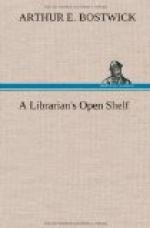In 1911, a committee was appointed by the British Association for the Advancement of Science “to inquire into the influence of school-books upon eyesight.” This committee’s report dwells on the fact that the child’s eye is still in process of development and needs larger type than the fully developed eye of the adult. In making its recommendation for the standardization of school-book type, which it considers the solution of the difficulty, the committee emphasizes the fact that forms and sizes most legible for isolated letters are not necessarily so for the groups that need to be quickly recognized by the trained reader. It dwells upon the importance of unglazed paper, flexible sewing, clear, bold illustrations, black ink, and true alignment. Condensed or compressed letters are condemned, as are long serifs and hair strokes. On the other hand, very heavy-faced type is almost as objectionable as that with the fine lines, the ideal being a proper balancing of whites and blacks in each letter and group. The size of the type face, as we might expect, is pronounced by the committee “the most important factor in the influence of books upon vision”; it describes its recommended sizes in millimetres—a refinement which, for the purposes of this article, need not be insisted upon. Briefly, the sizes run from thirty-point, for seven-year-old children, to ten-point or eleven-point, for persons more than twelve years old. Except as an inference from this last recommendation, the committee, of course, does not exceed its province by treating of type-sizes for adults; yet it would seem that it considers ten-point as the smallest size fit for anyone, however good his sight. This would bar much of our existing reading matter.
A writer whose efforts in behalf of sane typography have had practical results is Professor Koopman, librarian of Brown University, whose plea has been addressed chiefly to printers. Professor Koopman dwells particularly on the influence of short lines on legibility. The eye must jump from the end of each line back to the beginning of the next, and this jump is shorter and less fatiguing with the shorter line, though it




